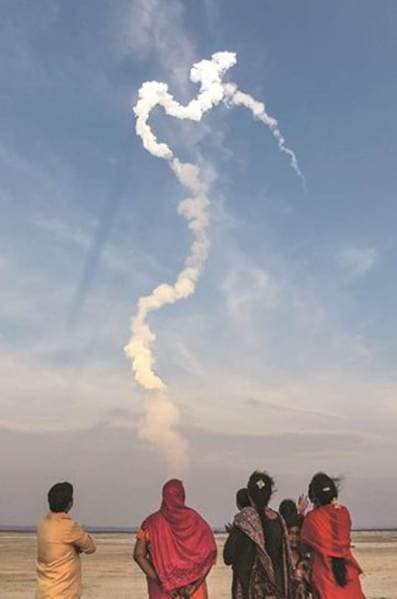 ISRO’s GSLV-MkIII rocket, carrying satellite GSAT-29, takes off from Satish Dhawan Space Centre in Sriharikota. PTI
ISRO’s GSLV-MkIII rocket, carrying satellite GSAT-29, takes off from Satish Dhawan Space Centre in Sriharikota. PTI
The Indian Space Research Organisation (ISRO) launched its heaviest satellite from Indian soil on Wednesday, in an operation that went almost precisely to the launch plan.
The heavy-lift GSLV Mk III rocket, ISRO’s most powerful rocket to date, launched the GSAT-29, a communication satellite weighing 3423 kg, into a Geosynchronous Transfer Orbit. The GSLV Mk III was launched at 5.08 pm from the Satish Dhawan Space Centre at Sriharikota in Andhra Pradesh. Though there were doubts over the launch on account of a cyclonic storm developing over the coast of Andhra Pradesh and Tamil Nadu, the launch was cleared on Tuesday by ISRO and the countdown started at 2.50 pm on Tuesday. The launch is expected to push ISRO’s space programmes forward on several fronts. “Today India has achieved a significant milestone. The GSLV Mk III, India’s heaviest launcher, has launched GSAT 29,’’ ISRO chairman K Sivan said, adding that the launch “completed the developmental flights’’ of the rocket.
The rocket
The GSLV Mk III is a three-stage heavy-lift rocket with two solid fuel strap-on engines in the first stage, a liquid propellant core as second stage and a cryogenic engine for the third stage. It is designed to carry satellites weighing in the range of 4000 kg into Geosynchronous Transfer Orbit (GTO) or satellites weighing about 10,000 kg to a Low Earth Orbit (LEO).
The GSLV Mk III’s flight on Wednesday was its second developmental flight. It was earlier flown on one experimental and one developmental flight. In its first flight on December 18, 2014 the GSLV Mk III carried a Crew Module Atmospheric Re-entry Experiment (CARE) — a precursor to the first Indian human space flight — weighing 3,775 kg.
In its first development flight on June 5, 2017 the GSLV Mk III D1 successfully launched a 3,136 kg GSAT-19 satellite — the heaviest satellite launched from Indian soil at the time.
The cryogenic upper stage in the GSLV Mk III rocket, called the C25 engine, is an improvement on C20 cryogenic engines used in the GSLV Mk II rockets which entered the operational phase after over 25 years of development in September 2016 following the successful flight of the GSLV F05 with a 2,211-kg INSAT-3DR weather satellite.
The indigenous cryogenic C25 stage engine operates on Gas Generator Cycle using extremely low temperature propellants Liquid Hydrogen (LH2) at 20 Kelvin ( -253°C) and Liquid Oxygen (LOX) at 80K (-193°C), according to ISRO statements.
The cryogenic stage is a highly efficient rocket stage that provides more thrust for every kg of propellant it burns compared to the solid and earth-storable liquid propellant stages. The specific impulse achievable with cryo fluids is 450 seconds compared to 300 seconds for other fuels.
According to space scientists, cryogenic engines provide unprecedented power in terms of thrust to GSLV rockets in their final stages while keeping fuel loads on the rocket relatively low. Nearly 50 per cent of the power for GSLV rockets as they push into space comes from the cryogenic stage.
“The cryogenic Stage of GSLV Mk III is one of the most powerful Cryogenic stages developed in the world and it generates nearly 2 MW power,’’ ISRO said ahead of the launch. Compared to the 12.5-tonne propellant used in cryogenic engine of the GSLV Mk-II, the C25 stage has a higher propellant loading at 27 tonnes and higher engine thrust — 19 tonnes versus 7.5 tonnes. Following the successful flight of the GSLV Mk III D2 on Wednesday, the director of Vikram Sarabhai Space Centre S Somanath said the rocket “is a vehicle for the future’’. He said ISRO is in the midst of improving capabilities of the rocket to enable it to carry payloads in the range of 6000 kg.
The satellite
The 3423 kg GSAT-29 satellite carries communication transponders to provide communication in remote regions of India. The satellite will provide communication services to the northeast and Jammu and Kashmir to facilitate execution of Digital India initiatives, ISRO has stated. “The GSAT 29 carries Ka/Ku-band high throughput communication transponders intended to meet the communication requirements of users including those in remote areas. In addition, several new technologies such as Q/V-band payload, data transmission through optical communication link will be demonstrated. This will help in realising future advanced satellites,’’ the agency said.
The significance
The GSLV Mk III rocket has been designated as the launch vehicle for India’s second moon mission Chandrayaan 2 which is scheduled for January next year and India’s first human space flight which is being targeted for 2022 as per an announcement made by Prime Minister Narendra Modi on August 15.
A successful flight for the GSLV Mk III was crucial to expedite ISRO’s moon and man missions. The rocket is expected to undergo 10 flights, including two in an unmanned human space launch vehicle form prior to launching humans to space in 2022. In the December 2014 experimental flight, the GSLV Mk III carried a 3,775 kg crew module to a height of 126 km before it “separated from the upper stage of GSLV Mk-III and re-entered the atmosphere and safely landed over the Bay of Bengal with the help of its parachutes about 20 minutes and 43 seconds after lift-off’’.
Secondly, the successful launch of the GSLV Mk III makes the rocket a viable choice for ISRO to use while launching communication satellites weighing over 2,500 kg.
India first ventured on the path of obtaining the cryogenic technology used in the GSLV rockets in 1992 with a two- pronged strategy of purchasing cryogenic engines from Russia and acquiring the technology from the US.
India is among six nations — apart from the US, Russia, France, Japan and China — to possess cryogenic engine technology, a key frontier in rocket science.